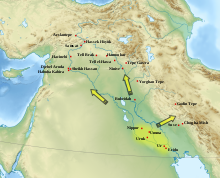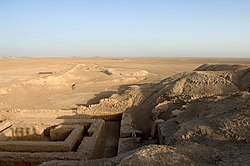
Back Uruk-tydperk Afrikaans فترة أوروك Arabic Període d'Uruk Catalan Урук тапхăрĕ CV Uruk-kulturen Danish Uruk-Zeit German Período de Uruk Spanish Uruk Aroa Basque دوره اوروک Persian Uruk-kausi Finnish
 | |
| Geographical range | Mesopotamia |
|---|---|
| Period | Copper Age |
| Dates | c. 4000–3100 BC |
| Type site | Uruk |
| Preceded by | Ubaid period |
| Followed by | Jemdet Nasr period |
The Uruk period (c. 4000 to 3100 BC; also known as Protoliterate period) existed from the protohistoric Chalcolithic to Early Bronze Age period in the history of Mesopotamia, after the Ubaid period and before the Jemdet Nasr period.[1] Named after the Sumerian city of Uruk, this period saw the emergence of urban life in Mesopotamia and the Sumerian civilization.[2] The late Uruk period (34th to 32nd centuries) saw the gradual emergence of the cuneiform script and corresponds to the Early Bronze Age; it has also been described as the "Protoliterate period".[3][4]
It was during this period that pottery painting declined as copper started to become popular, along with cylinder seals.[5]
| History of Iraq |
|---|
 |
|
|
- ^ Crawford 2004, p. 69
- ^ Crawford 2004, p. 75
- ^ As for example in Frankfort 1970, where the first chapter covers the period.
- ^ "Cuneiform Digital Library Initiative". Archived from the original on 2021-04-13. Retrieved 2020-04-27.
- ^ Langer 1972, p. 9